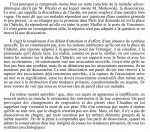
Dissociation et mémoire traumatique, Dunod, 2012 – 2019.
Un ouvrage qui comporte un historique assez complet de la notion de dissociation, sans encore d’équivalent actuellement. La contribution de Pierre Janet est restituée dans son contexte, ainsi que dans ses dimensions actuelles. À relire (...)
Un article de Lucien Oulahbib
Abstract
Returning to the work of the psychologist Pierre Janet, a contemporary and friend of Henri Bergson, is no exercise in nostalgia : new psychological therapeutic practices structured around the concepts of trauma and dissociation—which argue that the (...)
HISTORIQUE DE LA BIBLIOGRAPHIE DE PIERRE JANET → ACCES DIRECT À LA BIBLIOGRAPHIE DE PIERRE JANET
Pierre Janet n’a pas tenu lui-même sa bibliographie. Comme le signale le professeur C. Prévost dans sa thèse, publiée chez Payot en 1973 ("La psycho-philosophie de Pierre Janet"), l’histoire de (...)

Article du Magazine Bourg-la-Reine il y a 10 ans, à l’occasion des célébrations du 150è anniversaire de Pierre Janet, qui y avait passé son enfance et sa jeunesse.
Consultez ici ! (PDF)
Tout nouveau site Internet avec d’abondantes ressources bibliographiques sur Pierre Janet, du grand spécialiste européen Onno van der Hart.
Cliquer ici !
REVUE DE PRESSE
« Ce volume est autant une découverte qu’une redécouverte. Le véritable impact de Pierre Janet est intemporel. Pourquoi ? Parce que sa sensibilité relationnelle durable est dans sa prescience. La pleine puissance de son" ici-et-maintenant" est la mieux appréciée par ceux qui (...)
.
PTSD post-diagnostic du cancer : « déni » ou amnésie dissociative ?
PTSD after cancer diagnosis : “Denial” or dissociative amnesia ?
European Journal of Trauma & Dissociation Volume 2, Issue 4, October–December 2018, Pages 197-205.
Psycho-oncologie, la position de Pierre Janet / (...)
Les livres papier et numérique sont en vente sur le site de l’éditeur, L’Harmattan. Mais la page d’Amazon présente l’intérêt de proposer aussi des livres d’occasion, et même parfois d’anciennes éditions, comme celles de la Société P. Janet (1970 - 1999).
Suivre ce (...)

La psychologie clinique, il y a bien longtemps, désignait une spécialité de la recherche en psychologie fondée sur l’entretien clinique, c’est à dire sur le processus d’interrogation des sujets aux fins de rassembler le maximum d’informations sur leur biographie. Ces données servaient ensuite à définir (...)
Quelques extraits du paragraphe « DISSOCIATION/ASSOCIATION EN FRANCE JUSQU’À RIBOT ». Section 100% histoire réalisée en compilant de nombreux articles et chapitres d’historiens... tous dûment cités !
DISSOCIATION/ASSOCIATION EN FRANCE JUSQU’À RIBOT
Dans la 2ème moitié du 19ème siècle, les (...)


En 1911, Bleuler crée le concept d’autisme et en fait l’un des symptômes de la schizophrénie, une pathologie qu’il pense de nature dissociative. En 1927, Janet conteste la nature dissociative de la schizophrénie, et donc, de l’autisme. Pour lui (qui est l’auteur du concept sous sa forme moderne), la (...)
-
 2è édition de notre manuel
2è édition de notre manuel
par Isabelle Saillot
Rubrique : Livres
-
 Criminology comes back (...)
Criminology comes back (...)
par Isabelle Saillot
Rubrique : Revues de recherche
-
 Oeuvres complètes de (...)
Oeuvres complètes de (...)
par Isabelle Saillot
Rubrique : Oeuvres complètes de Pierre
-
Il y a 10 ans : Janet (...)
par Isabelle Saillot
Rubrique : Pierre Janet
-
 Nouveau site Internet (...)
Nouveau site Internet (...)
par Isabelle Saillot
Rubrique : Sur le web
-
 Rediscovering Pierre (...)
Rediscovering Pierre (...)
par Isabelle Saillot
Rubrique : Livres
-
 Pierre Janet et le PTSD
Pierre Janet et le PTSD
par Isabelle Saillot
Rubrique : Revues de recherche
-
 Tout Pierre Janet sur (...)
Tout Pierre Janet sur (...)
par Isabelle Saillot
Rubrique : Pierre Janet
-
 Autisme / Asperger : (...)
Autisme / Asperger : (...)
par Isabelle Saillot
Rubrique : Bibliographie : études sur (...)
-
 TROUBLES DISSOCIATIFS (...)
TROUBLES DISSOCIATIFS (...)
par Isabelle Saillot
Rubrique : Livres
-
 Autisme / Asperger : (...)
Autisme / Asperger : (...)
par Isabelle Saillot
Rubrique : Bibliographie : études sur (...)
- Atelier Européen de thérapie du psychotrauma à Paris
- Atelier Européen ESTD à Paris !
- COLLOQUE : DISSOCIATION ET MEMOIRE TRAUMATIQUE
- Colloque autour de Pierre Janet
- Conférence sur la psychopathologie de Pierre Janet
- Congrès de la SFP : programme
- Congrès National de la SFP : Metz 2011
- Création du CENTRE PIERRE JANET, Metz
- Exposition LA MESURE DE LA VIE MENTALE
- First European Workshop supported by ESTD
- Formation au traitement des troubles dissociatifs
- Inauguration de l’ASSOCIATION FRANÇAISE PIERRE JANET
- Janet mentionné par P.-H. Castel sur France Culture
- La revue Dogma, dorénavant animée par L. Oulahbib et I. Saillot
- La Société Française de Psychologie « protège » Pierre Janet !
- L’Institut Pierre Janet n’est plus...
- Prix Pierre Janet / Pierre Janet Writing Award 2011
- Traitement des amnésies traumatiques à l’IETSP
- Workshop du 3 décembre 2011 : intervention de Hélène Dellucci
- Workshop du 3 décembre 2011 : intervention de Onno van der Hart
- Workshop du 3 décembre 2011 : intervention de Pat Ogden
- Workshop du 3 décembre 2011 : intervention de Suzette Boon
- Workshop du 3 décembre : un événement majeur pour Janet et la dissociation en France !
- 10 et 11 mars 2012 : Formation à la Théorie de la dissociation
- T. Lempérière et la Société Pierre Janet
- À lire et à relire : ‘La médecine psychologique’ de Pierre Janet !
- A short autobiography of Pierre Janet
- Fonds Pierre Janet du Collège de France
- Généalogie complète de Pierre Janet !
- Il y a 10 ans : Janet à l’honneur à Bourg-la-Reine !
- Mise aux enchères d’une photo de Janet !
- Pierre Janet à l’honneur à la S.F.P. !
- Tout P. Janet à l’Harmattan
- Tout Pierre Janet sur Amazon
- Un portail francophone sur Pierre Janet
-
Colloques et congrès
- Congrès "Marcel Jousse"
- Congrès 2017 de la Société Française de Psychologie : plusieurs interventions sur Pierre Janet !
- Congrès 2018 de la Société Française de Psychologie : interventions sur Pierre Janet.
- Congrès international ICAP !
- En partenariat avec l’I.M.I : COLLOQUE D’UNE JOURNÉE SUR PIERRE JANET
- Pierre Janet à l’ICAP !
- IETSP et AFPJ
-
Livres
- International Psychology ? Pierre Janet !
- Le Soi Hanté : bientôt 2 ans !
- MAI 2012 : sortie du livre sur le PSYCHOTRAUMATISME (Dunod) dont j’ai fait le premier chapitre
- Nouveau livre sur Pierre Janet
- Pierre Janet présenté aux USA !
- Rediscovering Pierre Janet
- Trauma and the Body bientôt - et enfin - traduit en français !
- TROUBLES DISSOCIATIFS (...), DUNOD, mai 2012 : quelques extraits de mon chapitre (1)
- TROUBLES DISSOCIATIFS (...), DUNOD, mai 2012 : quelques extraits de mon chapitre (2)
- TROUBLES DISSOCIATIFS (...), DUNOD, mai 2012 : quelques extraits de mon chapitre (3)
- 2è édition de notre manuel Dissociation et mémoire traumatique
- Revue Dogma
- Société Française de Psychologie
- Sur le web
-
Revues de recherche
- Criminology comes back to Pierre Janet / Pierre Janet aux sources de la criminologie
- Europ. journ. of trauma and diss. : Pierre Janet !
- I. Saillot : bibliographie sur P. Janet 2013-2018 (articles / sélection)
- La revue Psychologie Française accepte mon 2ème article sur l’actualité de Pierre Janet
- Le traitement psychologique du stress post-traumatique de Pierre Janet
- Pierre Janet & émotions et mémoire
- Pierre Janet en psycho. de la religion
- Pierre Janet en psychologie sociale !
- Pierre Janet et le PTSD post-diagnostic du cancer
- Pierre Janet et le Trouble dissociatif : article sous presse !
- PIERRE JANET ET L’ANONYMAT : nouvel article !
- Année / Year 2004
- Année / Year 2005
- Année / Year 2006
- Année / Year 2007
- Fascicule du cent cinquantenaire de Janet
Dissociation et mémoire traumatique, Dunod, 2012 – 2019.

Un ouvrage qui comporte un historique assez complet de la notion de dissociation, sans encore d’équivalent actuellement. La contribution de Pierre Janet est restituée dans son contexte, ainsi que dans ses dimensions actuelles. À relire !
Identification
Articles les plus vus
-
I. Saillot : bibliographie sur P. Janet 2013-2018 (articles / sélection)
(vu 172628 fois)
-
COLLOQUE : DISSOCIATION ET MEMOIRE TRAUMATIQUE
(vu 152243 fois)
-
MAI 2012 : sortie du livre sur le PSYCHOTRAUMATISME (Dunod) dont j’ai fait le premier chapitre
(vu 103821 fois)
-
La revue Psychologie Française accepte mon 2ème article sur l’actualité de Pierre Janet
(vu 98998 fois)
-
Interview de Pat Ogden, thérapeute américaine spécialiste de Janet
(vu 79231 fois)



 Plan du site
Plan du site
